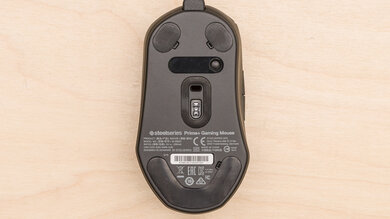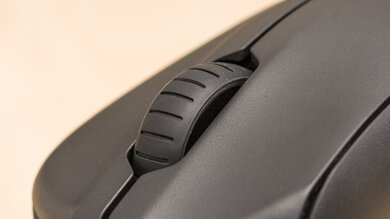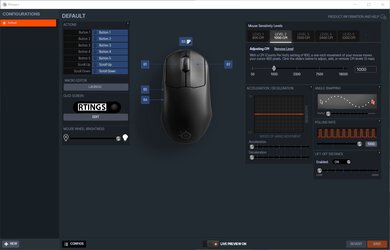The SteelSeries Prime+ is a very good wired gaming mouse. It's lightweight, it feels very sturdy, and it has a comfortable right-handed shape. It boasts several unusual features, including a dedicated secondary sensor that SteelSeries claims can provide extremely low lift-off distances and optical-magnetic switches advertised to be quicker and more responsive. However, neither of these is something we test. It also has an OLED screen on the mouse's underside, which you can use to customize the polling rate, RGB lighting, lift-off distance, and CPI settings without using the companion software. Unfortunately, while it has impressive sensor performance, its click latency is high for a wired gaming mouse.
Our Verdict
The SteelSeries Prime+ is decent for office and multimedia use. It feels very well-built and has a comfortable right-handed shape that's well-suited for all grip types and most hand sizes. It has a good number of buttons you can program using the companion software, which is compatible with both Windows and macOS. Unfortunately, this mouse has no wireless connectivity options, and the mouse wheel lacks L/R tilt buttons and doesn't unlock for free scrolling.
- Feels very well-built.
- Software is compatible with Windows and macOS.
- Wired-only.
- Mouse wheel lacks L/R tilt buttons and doesn't unlock for free scrolling.
The SteelSeries Prime+ is a great FPS gaming mouse, but it has significantly higher latency than most wired gaming mice. That said, it's lightweight, feels very sturdy, and has a shape that's well-suited to all grip types and most hand sizes. It also has a fairly flexible cable, mouse feet that glide well on all surfaces, a wide CPI range, a CPI you can adjust by increments of 50, and a very low lift-off distance.
- Feels very well-built.
- Suitable for all grip types and most hand sizes.
- Lightweight.
- High click latency.
The SteelSeries Prime+ is a very good mouse for MMO gaming, though it doesn't have nearly as many side buttons as a dedicated MMO mouse. That said, all of the buttons on the top of the mouse are programmable using the companion software compatible with Windows and macOS. Performance-wise, it has a wide CPI range, a CPI you can adjust by increments of 50, and a very low lift-off distance. Unfortunately, the click latency is high, and some gamers may prefer a more responsive-feeling option.
- Feels very well-built.
- Suitable for all grip types and most hand sizes.
- Software is compatible with Windows and macOS.
- High click latency.
- Not nearly as many progammable side buttons as a dedicated MMO mouse.
The SteelSeries Prime+ is a great ultra-light gaming mouse. It's lightweight, feels very well-built, and its right-handed shape is well-suited to all grip types and most hand sizes. It also has a good quality paracord-like cable that's fairly flexible and mouse feet that glide well on both mousepads and tables. Performance-wise, it has a wide CPI range, a CPI you can adjust by increments of 50, and a very low lift-off distance. Unfortunately, its click latency is significantly higher than most other wired gaming mice, and some gamers may notice delays, particularly in fast-paced or competitive games.
- Feels very well-built.
- Suitable for all grip types and most hand sizes.
- Lightweight.
- High click latency.
The SteelSeries Prime+ is inadequate for travel use. Its somewhat bulky design makes it unlikely to fit into most laptop cases, and you can't use it wirelessly, which can be cumbersome in tight spaces like buses, trains, or planes. That said, it does feel very well-built, the cable is detachable, and there's an OLED screen on the underside, which you can use to adjust mouse settings without the companion software.
- Feels very well-built.
- Bulky; may not fit in most laptop cases.
- Wired-only.
Check Price
Differences Between Sizes And Variants
The SteelSeries Prime+ belongs to a lineup of three similar SteelSeries mice, which all share the same ergonomic shape. The other versions include the SteelSeries Prime, another wired version that lacks the OLED screen on the bottom, and the SteelSeries Prime Wireless, which lacks the OLED screen, but you can use it wirelessly. The unit we tested is black, and there are no other color variants. You can see the label for our unit here.
Popular Mouse Comparisons
The SteelSeries Prime+ is a feature-rich, wired gaming mouse and one of the three mice in SteelSeries's Prime lineup. Unique to this version, this mouse has an OLED screen on the underside that you can use to customize settings without using the companion software. This feature can be helpful if you often switch computers or attend events like LAN tournaments and can't always rely on software for customization. Altogether, it has solid sensor performance and several uncommon features, but it also has significantly higher click latency than most other gaming mice at this price point, so it may not be a great fit if you exclusively play fast-paced or competitive games.
For more options, check out our recommendations for the best wired mice, the best gaming mice, and the best SteelSeries mice.
The SteelSeries Prime and the SteelSeries Prime+ are similar wired gaming mice from the same lineup. The SteelSeries Prime is marginally lighter, but the SteelSeries Prime+ has an OLED screen on the underside that you can use to customize settings without using the companion software. It also has a secondary sensor dedicated to detecting lift-off distance. Although both mice have differently-named sensors, they perform almost identically.
The Logitech G PRO X SUPERLIGHT is a better gaming mouse than the SteelSeries Prime+. You can use the Logitech wired or wirelessly. It's significantly lighter, and it has smoother gliding mouse feet. It also has a higher maximum CPI, a much lower click latency. Comparatively, the SteelSeries is a wired-only mouse with a lower minimum CPI and an OLED screen on the bottom of the mouse that you can use to change sensor settings without the companion software. Both mice are well-suited for all grip types, and nearly all hand sizes, but the Logitech is more accommodating to more hand sizes overall.
The GLORIOUS Model D and the SteelSeries Prime+ are both impressive, wired gaming mice. The SteelSeries feels sturdier and has a detachable cable. It also has a wider CPI range, a lower lift-off distance, customization software for Windows and macOS, and an OLED screen on the bottom for making on-the-fly settings adjustments without the software. On the other hand, the GLORIOUS has a more flexible cable, mouse feet that glide more smoothly, and a much lower click latency. Unfortunately, its software is only compatible with Windows. Both mice are well-suited for all grip types and nearly all hand sizes.
The SteelSeries Aerox 3 (2022) and the SteelSeries Prime+ are both wired gaming mice. The Aerox has an ambidextrous honeycomb design and is much lighter. It has a CPI button behind its scroll wheel and larger, better-quality mouse feet. On the other hand, the Prime+ has a solid body with a right-handed design and feels much better built. There's a programmable OLED screen on the underside that lets you change your settings without needing to use the software. Also, it has a dedicated lift-off distance sensor that SteelSeries claims can help it achieve a much lower lift-off distance. Also, its cable is better quality and more flexible.
Test Results

The body feels very sturdy and has a slightly textured matte finish. There isn't any flex when you squeeze the body and no rattling sounds if you shake the mouse. All buttons provide good physical feedback and feel responsive. There's a slight wobble and side-to-side movement in the scroll wheel, but this shouldn't be noticeable during normal use.
The SteelSeries Prime+ has a slightly textured matte plastic body and a grippy, rubberized scroll wheel. Its right-handed ergonomic shape is well-suited for all grip types and most hand sizes. For a similar wired gaming mouse that has a range of modular pieces available to adjust the look and feel of the mouse, check out the Pwnage Ultra Custom Ergo.
The cable feels very good quality. However, it's not quite as flexible as other paracord-like cables we've tested, and it retains kinks from packaging. Even though this is a wired-only mouse, the cable is removable, which is great for portability but can also be helpful if the cable gets damaged and needs replacing.
The polling rate settings on the SteelSeries Prime+ are 125Hz, 250Hz, 500Hz, and 1000Hz. You can adjust the polling rate and many other settings using the companion software or the OLED screen on the underside of the mouse. If you're looking for a wired gaming mouse with a higher maximum polling rate, check out the Mad Catz B.A.T. 6+.
Note: This mouse also has a dedicated secondary sensor that SteelSeries claims can achieve lift-off distances as low as 0.5mm. However, this isn't something we test.
All buttons on the top of the mouse are programmable, including the mouse wheel up and down functions, the mouse wheel click, and left and right-click buttons. You can set up to five CPI profiles using the companion software, and you can cycle between them by assigning one of the buttons to act as a CPI button. There is an additional button on the underside used to interact with the screen on the bottom of the mouse, which you can use to customize CPI, lift-off distance, and other settings on the fly.
Note: This mouse uses magnetic optical-mechanical switches, which SteelSeries claims produce more consistent clicks and quicker response times. However, this isn't something we test.
Update 07/28/2021: We previously incorrectly stated that this mouse had 'quiet' click noises instead of 'loud' click noises. This review has been updated to reflect this change.
The SteelSeries Prime+ has satisfactory click latency, but it's higher than many similar mid-range gaming mice, and gamers may prefer a more responsive option, especially for fast-paced or competitive gaming.
The companion software has a clean and modern-looking interface with well laid-out settings and easy-to-control sliders.












